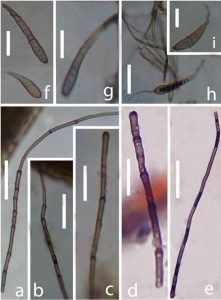Corynespora celastri Sham. Kumar & Raghv. Singh, sp. nov., Index Fungorum number: IF 817427
Etymology: The specific epithet celastri in reference to host genus.
Foliicolous, Infection spots initially hypogenous but later amphigenous, circular, subcircular to irregular, 5 to more than 20 mm in diameter, brown to blackish, necrotic. Colonies epiphyllous, effuse, greyish. Mycelium internal. Sexual morph: undetermined. Asexual morph: Stromata absent. Conidiophores solitary, macronematous, mononematous, cylindrical, erect to procumbent, straight to flexuous, unbranched, curved, thick-walled, smooth, 5–18-septate, with 3–8 successive cylindrical proliferations, mid brown, 135–200 × 3–5 µm. Conidiogenous cells integrated, terminal, brown, smooth, monotretic, scars unthickened. Conidia acrogenous, dry, solitary, unbranched, thin-walled, smooth, straight to slightly curved, usually obclavate to obclavate-cylindrical, 7–17-distoseptate with 0–1 transverse band like eusepta, 55–120 × 8–15 µm (x̅ = 87.5 × 11.5 μm, n = 15), apex obtuse to rounded, olivaceous to very light brown, hilum thickened, 3–5 µm wide, germinating conidia present.
Known distribution: India
Material examined: INDIA, Uttar Pradesh, Mahrajganj, Paniyara Forest, on living leaves of Celastrus paniculatus Willd. (Celastraceae), 6 November 2014, Shambhu Kumar, AMH 9687 (holotype), BSIPMH 031 (isotype).
Fig. 2 Corynespora celastri (holotype, AMH 9687). a–e Conidiophores. f–g Conidia. h– i Germinating conidia. Scale bars = 20 µm.

